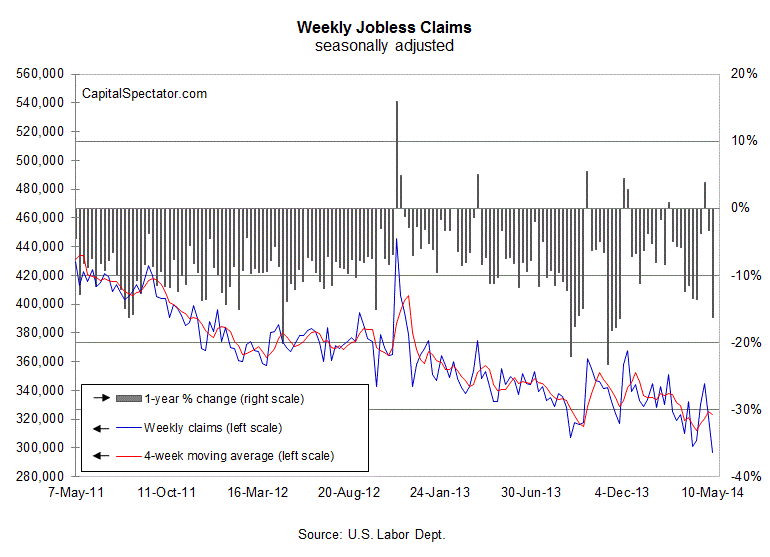Today’s reports on jobless claims and industrial production offer a mixed review for the macro outlook. On the one hand, the sharp decline in new filings for unemployment benefits to a seven-year low is a powerful signal for expecting continued growth in the labor market for the near term. But the surprisingly big slump in industrial output last month throws a bit of cold water on any celebration over the lesser pace of new layoffs. Even so, it’s premature to read too much into the monthly dive in industrial production since the year-over-year trend is still advancing at a decent pace.
Let’s start with the claims data. Last week’s filings dropped a hefty 27,000 to a seasonally adjusted 297,000—the lowest since May 2007. This could be noise, of course, but one reason for thinking that the latest drop is the genuine article: claims fell 16% last week vs. a year ago. That’s the biggest annual decline since last November. In other words, the broad trend in claims continues to point to growth with regards to the economy’s ability to create jobs on a net-positive basis.
Industrial production, by contrast, suffered a setback last month. Output unexpectedly fell in April. But the 0.6% decline isn’t as bad as it looks because the year-over-year growth in industrial activity is still chugging higher at a decent if unspectacular rate. Even after the latest stumble, industrial production increased 3.5% in the year through April. That’s the second-fastest pace in the past six months and it offers support for thinking that April’s monthly decline doesn’t reflect the broad trend.
Keep in mind, however, that the cyclically sensitive manufacturing component is a bit weaker vs. than the headline industrial output data. Manufacturing retreated 0.4% last month, which reduced the year-over-year gain to 2.9% (a bit slower than the previously reported annual rate). Is this a problem? Possibly, if there’s more deceleration to come. But for now, it’s premature to say that it’s more than a one-time glitch. Indeed, moderate growth still prevails in the industrial sector generally. Meantime, the ISM Manufacturing Index ticked up last month, suggesting a slightly stronger growth rate as well. The upbeat data in jobless claims today also tells us that moderate growth is still intact on a big-picture macro level.
There’s still plenty to worry about, of course. The housing market in particular has been soft lately. But based on today’s news for industrial production and jobless claims, the broad trend still looks convincingly biased toward expansion.

